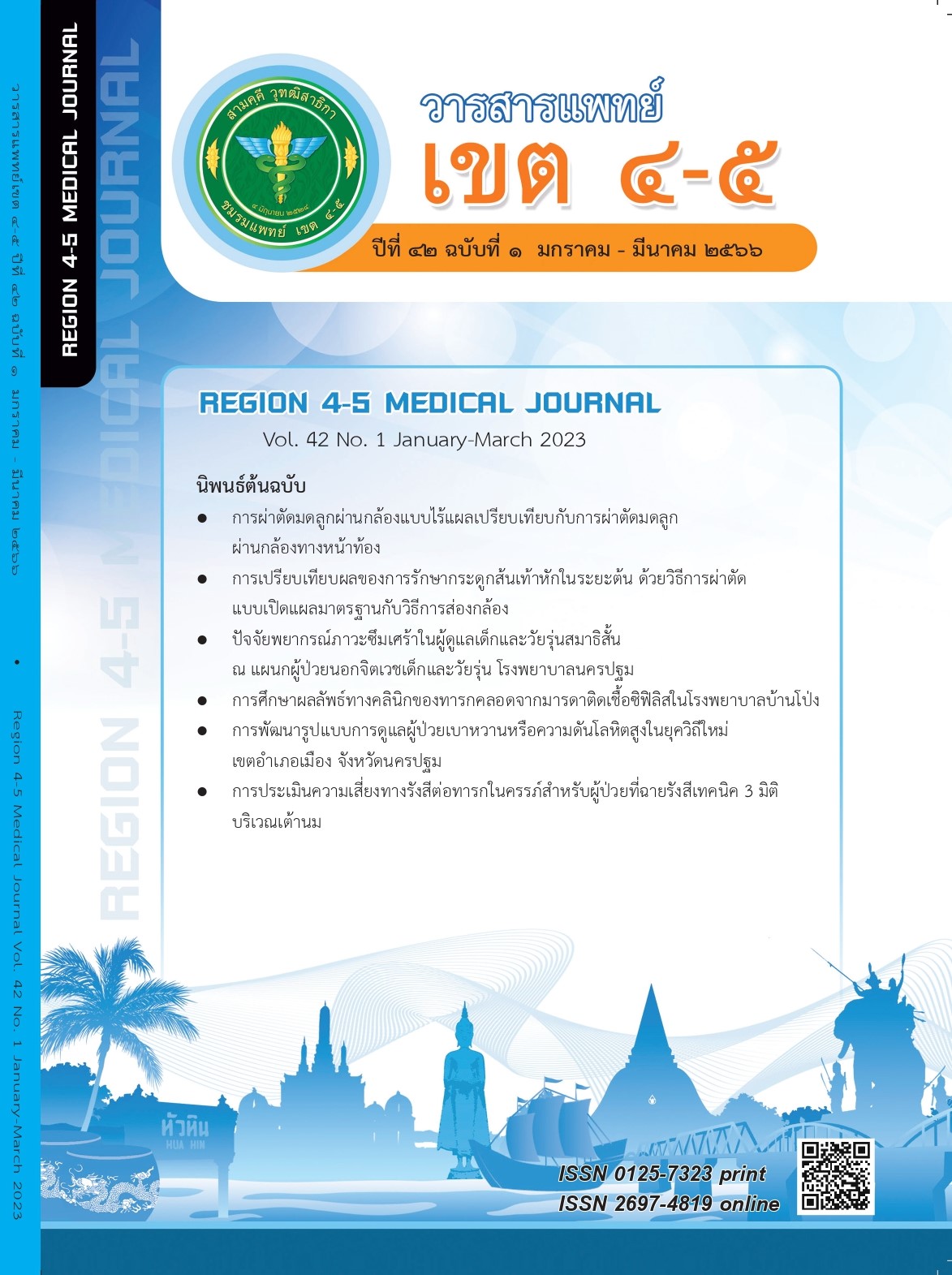การเปรียบเทียบภาวะแทรกซ้อนและผลลัพธ์การรักษาของการดึงถ่วงน้ำหนักผ่านผิวหนังระหว่าง 7 วัน และ 14 วัน ในผู้ป่วยสูงอายุข้อสะโพกหักที่รักษาด้วยการไม่ผ่าตัด ในโรงพยาบาลมะการักษ์ จังหวัดกาญจนบุรี
คำสำคัญ:
การดึงถ่วงน้ำหนักผ่านผิวหนัง, ผู้ป่วยสูงอายุข้อสะโพกหัก, ภาวะแทรกซ้อน, ผลลัพธ์การรักษาบทคัดย่อ
วัตถุประสงค์: เพื่อ 1) เพื่อเปรียบเทียบภาวะแทรกซ้อนระหว่างการดึงถ่วงน้ำหนักผ่านผิวหนังระหว่าง 7 วัน กับ 14 วัน ในผู้ป่วยสูงอายุข้อสะโพกหักที่รักษาด้วยการไม่ผ่าตัด และ 2) เปรียบเทียบผลลัพธ์การรักษาระหว่าง การดึงถ่วงน้ำหนักผ่านผิวหนังระหว่าง 7 วัน กับ 14 วัน ในผู้ป่วยสูงอายุข้อสะโพกหักที่รักษาด้วยการไม่ผ่าตัด
วิธีการศึกษา: การศึกษาวิจัยนี้เป็นการศึกษาเชิงวิเคราะห์จากเหตุไปหาผล โดยเก็บข้อมูลย้อนหลังจากเวชระเบียนในผู้ป่วยที่มีอายุตั้งแต่ 65 ปีขึ้นไป ได้รับการวินิจฉัยว่ากระดูกสะโพกหักชนิด closed femoral neck fracture หรือ close intertrochanteric fracture และได้รับการรักษาแบบไม่ผ่าตัดด้วยการดึงถ่วงน้ำหนักผ่านผิวหนัง ที่โรงพยาบาลมะการักษ์ จังหวัดกาญจนบุรี ตั้งแต่เดือนมกราคม พ.ศ. 2560 ถึงเดือนธันวาคม พ.ศ. 2563 จำนวน 110 คน แบ่งเป็นกลุ่มที่ได้รับการดึงถ่วงน้ำหนักผ่านผิวหนังระหว่าง 7 วัน จำนวน 51 คน และกลุ่มที่ได้รับการดึงถ่วงน้ำหนักผ่านผิวหนังระหว่าง 14 วัน จำนวน 59 คน แล้วเปรียบเทียบภาวะแทรกซ้อนและผลลัพธ์การรักษา สถิติที่ใช้ในการวิเคราะห์ข้อมูลประกอบด้วยสถิติเชิงพรรณนา ได้แก่ การแจกแจงความถี่ ร้อยละ ค่าเฉลี่ย ค่าส่วนเบี่ยงแบนมาตรฐาน และสถิติอ้างอิง ได้แก่ independent t test และ chi-square test
ผลการศึกษา: ผู้ป่วยสูงอายุข้อสะโพกหักที่รักษาแบบไม่ผ่าตัดด้วยการดึงถ่วงน้ำหนักผ่านผิวหนังระหว่าง 7 วัน และ 14 วัน มีข้อมูลทั่วไปที่คล้ายคลึงกัน การเปรียบเทียบด้านภาวะแทรกซ้อนพบว่า การติดเชื้อระบบทางเดินปัสสาวะ การเกิดแผลกดทับ ปอดอักเสบ ภาวะสับสนเฉียบพลัน ภาวะไตวายเฉียบพลัน ภาวะหัวใจล้มเหลว และภาวะหัวใจเต้นผิดจังหวะ มีอัตราการเกิดไม่แตกต่างกันทั้ง 2 กลุ่ม ยกเว้นการเกิดโรคติดเชื้อระบบทางเดินหายใจส่วนบนพบว่า ในกลุ่มที่รักษาด้วยการดึงถ่วงน้ำหนัก 7 วัน เกิดขึ้นน้อยกว่าโดยมีความแตกต่างอย่างมีนัยสำคัญทางสถิติ ด้านผลลัพธ์ของการรักษาพบว่า กลุ่มรักษาด้วยการดึงถ่วงน้ำหนัก 7 วัน มีจำนวนวันนอนโรงพยาบาลและค่าใช้จ่ายที่เกิดขึ้นในโรงพยาบาลน้อยกว่ากลุ่มรักษาด้วยการดึงถ่วงน้ำหนัก 14 วัน โดยมีความแตกต่างกันอย่างมีนัยสำคัญทางสถิติ (p < .001) ด้านการเปรียบเทียบอัตราการเสียชีวิตหลังการบาดเจ็บที่ 30 วันและ 1 ปี พบว่า กลุ่มรักษาด้วยการดึงถ่วงน้ำหนัก 7 วัน มีอัตราการเสียชีวิตน้อยกว่ากลุ่มที่รักษาด้วยการดึงถ่วงน้ำหนัก 14 วัน แต่ไม่มีความแตกต่างกันอย่างมีนัยสำคัญทางสถิติ และด้านความสามารถในการใช้ชีวิตประจำวันในผู้ป่วยสูงอายุข้อสะโพกหักโดยประเมินจาก Barthel index score พบว่า คะแนนการประเมิน ADL ที่ 30 วัน และ 6 เดือน ในกลุ่มที่รักษาด้วยการดึงถ่วงน้ำหนัก 7 วัน มีคะแนนมากกว่ากลุ่มที่รักษาด้วยการดึงถ่วงน้ำหนัก 14 วัน โดยมีความแตกต่างกันอย่างมีนัยสำคัญทางสถิติ (p < .001 และ p < .05 ตามลำดับ) ส่วนคะแนนการประเมิน ADL ที่ 1 ปี ของทั้ง 2 กลุ่ม ไม่พบความความแตกต่างกันทางสถิติ
สรุป: ผลของการดึงถ่วงน้ำหนักผ่านผิวหนังระหว่าง 7 วัน กับ 14 วัน ในผู้ป่วยกระดูกข้อสะโพกหักที่รักษาด้วยการไม่ผ่าตัดในโรงพยาบาลมะการักษ์ จังหวัดกาญจนบุรี โดยการดึงถ่วงน้ำหนักผ่านผิวหนัง 7 วัน มีภาวะแทรกซ้อนน้อยกว่าและให้ผลลัพธ์ของการรักษาดีกว่า การดึงถ่วงน้ำหนักผ่านผิวหนัง 14 วัน
เอกสารอ้างอิง
Cheung CL, Ang SB, Chadha M, et al. An updated hip fracture projection in Asia: The Asian Federation of Osteoporosis Societies study. Osteoporos Sarcopenia 2018;4(1):16-21. doi: 10.1016/j.afos.2018.03.003
Chariyalertsak S, Suriyawongpisal P, Thakkinstain A. Mortality after hip fractures in Thailand. Int J Orthop 2001;25(5): 294–7.
Tan ST, Tan WP, Jaipaul J, et al. Clinical outcomes and hospital length of stay in 2,756 elderly patients with hip fractures: a comparison of surgical and non-surgical management. Singapore Med J. 2017;58(5):253–7. doi: 10.11622/smedj.2016045.
Russell TA. Intertrochanteric fracture of the hip. In: Court-Brown CM, Heckman JD, McQueen MM, Ricci WM, Tornetta P, Editor. Section Four: Lower Extremity. Rockwood and Green's fractures in adults. 201;8(1): 2075–29.
Heim M, Adunski A, Chechick A. Nonoperative treatment of intracapsular fractures of the proximal femur. Clin Orthop Relat Res 2002;(399):35–41. DOI: 10.1097/00003086-200206000-00006
Lim WX, Kwek EBK. Outcomes of an accelerated nonsurgical management protocol for hip fractures in the elderly. J Orthop Surg (Hong Kong). 2018;26(3):2309499018803408. doi: 10.1177/2309499018803408.
Kim SJ, Park HS, Lee DW. Outcome of nonoperative treatment for hip fractures in elderly patients: A systematic review of recent literature. J Orthop Surg (Hong Kong) 2020;28(2):2309499020936848. doi: 10.1177/2309499020936848.
Handoll HH, Parker MJ. Conservative versus operative treatment for hip fractures in adults. Cochrane Database Syst Rev. 2008;(3):CD000337. doi: 10.1002/14651858.CD000337.pub2.
Parker MJ, Handoll HH, Bhargara A. Conservative versus operative treatment for hip fractures. Cochrane Database Syst Rev 2000;(4):CD000337. doi: 10.1002/14651858.CD000337.
Hornby R, Evans JG, Vardon V. Operative or conservative treatment for trochanteric fractures of the femur. A randomised epidemiological trial in elderly patients. J Bone Joint Surg Br. 1989;71(4):619–23. doi: 10.1302/0301-620X.71B4.2670950.
Jerre R, Doshé A, Karlsson J. Preoperative skin traction in patients with hip fractures is not useful. Clin Orthop Relat Res. 2000;(378):169–73. doi: 10.1097/00003086-200009000-00026.
Cserháti P, Kazár G, Manninger J, et al. Non-operative or operative treatment for undisplaced femoral neck fractures: a comparative study of 122 non-operative and 125 operatively treated cases. Injury 1996;27(8):583–8. doi: 10.1016/s0020-1383(96)00073-3.
Kawaji H, Uematsu T, Oba R, et al. Conservative Treatment for Fracture of the Proximal Femur with Complications. J Nippon Med Sch. 2016;83(1):2–5. doi: 10.1272/jnms.83.2.
Buord JM, Flecher X, Parratte S, et al. Garden I femoral neck fractures in patients 65 years old and older: is conservative functional treatment a viable option? Orthop Traumatol Surg Res. 2010;96(3):228–34. doi: 10.1016/j.otsr.2009.11.012.
Hansen BA, Solgaard S. Impacted fractures of the femoral neck treated by early mobilization and weight-bearing. Acta Orthop Scand 1978;49(2):180–5. doi: 10.3109/17453677809005748.
Jain R, Basinski A, Kreder HJ. Nonoperative treatment of hip fractures. International Orthopaedics (SICOT) 2003;27(1):11–7. doi: 10.1007/s00264-002-0404-y.
Kostka T, Praczko K. Interrelationship between physical activity, symptomatology of upper respiratory tract infections, and depression in elderly people. Gerontology 2007;53(4):187–93. doi: 10.1159/000100017.
Tanaka J, Seki N, Tokimura F, et al. Conservative treatment of Garden stage I femoral neck fracture in elderly patients. Arch Orthop Trauma Surg 2002;122(1):24–8. doi: 10.1007/s004020100318.
Moulton LS, Green NL, Sudahar T, et al. Outcome after conservatively managed intracapsular fractures of the femoral neck. Ann R Coll Surg Engl 2015;97(4):279–82. doi: 10.1308/003588415X14181254788809.
Raaymakers EL, Marti RK. Non-operative treatment of impacted femoral neck fractures. A prospective study of 170 cases. J Bone Joint Surg Br 1991;73(6):950–4. doi: 10.1302/0301-620X.73B6.1955443.
Kim SM, Moon YW, Lim SJ, et al. Prediction of survival, second fracture, and functional recovery following the first hip fracture surgery in elderly patients. Bone. 2012;50(6):1343–50. doi: 10.1016/j.bone.2012.02.633
Cornwall R, Gilbert MS, Koval KJ, et al. Functional outcomes and mortality vary among different types of hip fractures: a function of patient characteristics. Clin Orthop Relat Res. 2004;(425):64–71. doi: 10.1097/01.blo.0000132406.37763.b3.
Hagino T, Ochiai S, Wako M, et al. Comparison of the prognosis among different age groups in elderly patients with hip fracture. Indian J Orthop 2008;42(1):29–32. doi: 10.4103/0019-5413.38577.
Wijnen HH, Schmitz PP, Es-Safraouy H, et al. Nonoperative management of hip fractures in very frail elderly patients may lead to a predictable short survival as part of advance care planning. Acta Orthop. 2021;92(6):728–32. doi: 10.1080/17453674.2021.1959155.
Radosavljevic N, Nikolic D, Lazovic M, et al. Hip fractures in a geriatric population - rehabilitation based on patients needs. Aging Dis 2014;5(3):177-82. doi: 10.14336/AD.2014.0500177.
Loures FB, Chaoubah A, Maciel VS, et al. Cost-effectiveness of surgical treatment for hip fractures among the elderly in Brazil. Rev Bras Ortop. 2015;50(1):38–42. doi: 10.1016/j.rboe.2015.01.007
Xu DF, Bi FG, Ma CY, et al. A systematic review of undisplaced femoral neck fracture treatments for patients over 65 years of age, with a focus on union rates and avascular necrosis. J Orthop Surg Res. 2017;12(1):28. doi: 10.1186/s13018-017-0528-9.
van de Ree CLP, De Jongh MAC, Peeters CMM, et al. Hip Fractures in Elderly People: Surgery or No Surgery? A Systematic Review and Meta-Analysis. Geriatr Orthop Surg Rehabil. 2017;8(3):173–80. doi: 10.1177/2151458517713821
ดาวน์โหลด
เผยแพร่แล้ว
รูปแบบการอ้างอิง
ฉบับ
ประเภทบทความ
สัญญาอนุญาต

อนุญาตภายใต้เงื่อนไข Creative Commons Attribution-NonCommercial-NoDerivatives 4.0 International License.
ลิขสิทธิ์บทความเป็นของผู้เขียนบทความ แต่หากผลงานของท่านได้รับการพิจารณาตีพิมพ์ลงวารสารแพทย์เขต 4-5 จะคงไว้ซึ่งสิทธิ์ในการตีพิมพ์ครั้งแรกด้วยเหตุที่บทความจะปรากฎในวารสารที่เข้าถึงได้ จึงอนุญาตให้นำบทความในวารสารไปใช้ประโยชน์ได้ในเชิงวิชาการโดยจำเป็นต้องมีการอ้างอิงถึงชื่อวารสารอย่างถูกต้อง แต่ไม่อนุญาตให้นำไปใช้ในเชิงพาณิชย์




